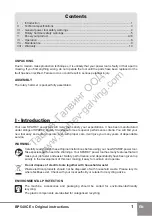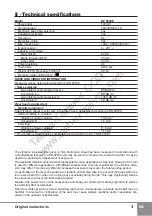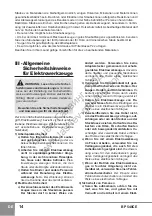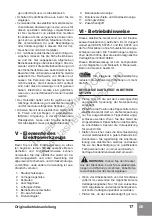
4
EN
BP 540CE
III - General power tool
safety warnings
WARNING! Read all safety warn-
ings and all instructions. Failure to follow
the warnings and instructions may result in
electric shock, fire and/or serious injury.
Save all warnings and instructions for
future reference.
The term “power tool” in the warnings refers
to your mains-operated (corded) power tool or
battery-operated (cordless) power tool.
1) Work area safety
a)
Keep work area clean and well lit. Clut-
tered or dark areas invite accidents.
b)
Do not operate power tools in explosive
atmospheres, such as in the presence
of flammable liquids, gases or dust.
Power tools create sparks which may ignite
the dust or fumes.
c)
Keep children and bystanders away
while operating a power tool. Distrac-
tions can cause you to lose control.
2) Electrical safety
a)
Power tool plugs must match the outlet.
Never modify the plug in any way. Do
not use any adapter plugs with earthed
(grounded) power tools.
Unmodified
plugs and matching outlets will reduce risk
of electric shock.
b)
Avoid body contact with earthed or
grounded surfaces, such as pipes, ra-
diators, ranges and refrigerators. There
is an increased risk of electric shock if your
body is earthed or grounded.
c)
Do not expose power tools to rain or wet
conditions. Water entering a power tool
will increase the risk of electric shock.
d)
Do not abuse the cord. Never use the
cord for carrying, pulling or unplugging
the power tool. Keep cord away from
heat, oil, sharp edges or moving parts.
Damaged or entangled cords increase the
risk of electric shock.
e)
When operating a power tool outdoors,
use an extension cord suitable for out-
door use. Use of a cord suitable for out-
door use reduces the risk of electric shock.
f)
If operating a power tool in a damp loca-
tion is unavoidable, use a residual current
device (RCD) protected supply. Use of an
RCD reduces the risk of electric shock.
3) Personal safety
a)
Stay alert, watch what you are doing
and use common sense when operating
a power tool. Do not use a power tool
while you are tired or under the influ
-
ence of drugs, alcohol or medication.
A moment of inattention while operating
power tools may result in serious personal
injury.
b)
Use personal protective equipment.
Always wear eye protection. Protective
equipment such as dust mask, non-skid
safety shoes, hard hat, or hearing protec-
tion used for appropriate conditions will re-
duce personal injuries.
c)
Prevent unintentional starting. Ensure
the switch is in the off-position before
connecting to power source and/or bat-
tery pack, picking up or carrying the
tool.
Carrying power tools with your finger
on the switch or energising power tools that
have the switch on invites accidents.
d)
Remove any adjusting key or wrench be-
fore turning the power tool on. A wrench
or a key left attached to a rotating part of the
power tool may result in personal injury.
e)
Do not overreach. Keep proper footing
and balance at all times. This enables
better control of the power tool in unexpect-
ed situations.
f)
Dress properly. Do not wear loose cloth-
ing or jewellery. Keep your hair, cloth-
Certain kinds of dust are classified as carcinogenic such as oak and beech dust especially in conjunc
-
tion with additives for wood conditioning (chromate, wood preservative). Material containing asbestos
must only be treated by specialists.
▪ Where the use of a dust extraction device is possible it shall be used.
▪ To achieve a high level of dust collection, use vacuum cleaner for wood or for wood and/or minerals
together with this tool.
▪ The work place must be well ventilated.
▪ The use of a dust mask of filter class P2 is recommended.
Follow national requirements for the materials you want to work with.
Та
ше
в
-
Га
лв
ин
г
ОО
Д
www.tashev-galving.com





























